Transport Infrastructure Development and Interregional Trade Flows: Evidence From Gansu Province
Abstract
This study employs a county-level refined computable general equilibrium (CGE) model to analyze the impact of transportation infrastructure in Gansu Province on inter-regional trade and coordinated regional development. The results indicate that infrastructure improvements exert a positive influence on regional trade, with long-term gains significantly outweighing short-term effects. Importantly, these impacts are heterogeneous across both sectors and regions. In particular, trade flows in Gansu shift from short-term resource outflows to long-term internal agglomeration, with resources increasingly concentrating in more competitive areas within the province. In terms of road types, national highways facilitate the inflow of resources from other provinces, while provincial roads enhance intraprovincial circulation but exacerbate regional disparities. Finally, regarding the mechanisms of influence, investment-led growth, through capital accumulation and multiplier effects, emerges as the primary driver of economic expansion, surpassing the role of trade facilitation. Our findings provide valuable insights for local governments in making strategic decisions about transportation infrastructure investment.
1. Introduction
The construction of transportation infrastructure is crucial for facilitating trade, representing a fundamental “hard” condition. The 19th Central Committee of the Communist Party of China, during its Fifth Plenary Session, approved the “Proposals for Formulating the 14th Five-Year Plan for National Economic and Social Development and the Long-Range Objectives for 2035.” This document emphasizes the imperative to accelerate the development of a new growth pattern encompassing both domestic circulation and a dual domestic–international circulation. To dismantle regional market segmentation and enhance internal resource allocation efficiency in China, the primary step is improving the transportation infrastructure [1]. The “14th Five-Year Plan for Modern Comprehensive Transportation System Development” addresses persistent imbalances and inadequacies in China’s transportation development, stressing the necessity to bridge gaps in the western regions’ infrastructure network and enhance overall connectivity as a critical component of establishing a modern comprehensive transportation system.
Gansu Province, situated in western China, serves as a key corridor along the historic Silk Road and plays a strategic role in linking eastern and western regions. In light of China’s shift toward a development strategy centered on domestic circulation supported by external openness, enhancing the transportation network in Gansu, particularly by closing infrastructure gaps and building a multidimensional transport system, has become increasingly important. Unlike the national objective of “connecting every city with high-speed rail,” Gansu’s focus on “connecting every county with expressways” represents a more grassroots-oriented initiative, directly targeting county-level development and rural welfare. Against this backdrop, this study selects Gansu as a representative case to explore the economic implications of the expressway projects included in its 14th Five-Year Plan, with particular emphasis on county-level outcomes.
Current literature on the relationship between transportation infrastructure and economic development predominantly employs difference-in-differences models or fixed effect models for econometric analysis [2, 3]. However, these methods face challenges in assessing inter-regional economic impacts. Some studies, adopting a new economic geography perspective, have effectively evaluated spatial spillover effects of transportation infrastructure improvements using spatial econometric models [4–6]. Yet, these studies typically conduct ex-post analyses using historical data, which complicates the depiction and anticipation of economic impacts for unconstructed projects and assesses systemic impacts of event shocks on the macroeconomy. A few studies have employed computable general equilibrium (CGE) models for the ex-post analysis of transportation infrastructure investment impacts on the economy [7], but regional model-based research, particularly concerning China’s county-level economies, remains relatively sparse. Therefore, this paper is committed to filling the gap in the existing literature by constructing a general equilibrium model for Gansu Province (The Enormous Regional Model [TERM] model), setting short-term and long-term scenarios, and distinguishing between provincial and national highway construction projects. It provides a detailed depiction of the impact of transportation infrastructure construction on inter-regional trade relations and its mechanisms during the 14th Five-Year Plan period.
The structure of the paper is as follows. Section 2 provides the literature review. Section 3 analyzes theoretical mechanisms. Section 4 explains research methods, data, and simulation schemes. Section 5 examines simulation results. Section 6 presents the conclusion, limitations, and prospects for future research.
2. Literature Review
The enhancement of transportation infrastructure plays a crucial role in fostering regional economic development, as evidenced by a robust body of literature exploring its economic effects. Existing studies categorize measurement methods into three main types. First, some studies quantify transportation infrastructure impacts using investment amounts [8]. Second, accessibility indices, such as the transportation infrastructure density index, constitute a second measurement method [2, 7]. Third, dummy variables are used to denote transit points, assigning a value of 1 to regions serving as transit hubs and 0 otherwise [9].
Broadly speaking, most studies converge on the conclusion that the construction and upgrading of transportation infrastructure exert positive effects on regional economic performance and welfare levels [2, 10, 11]. Notably, however, the impacts of different types of transportation infrastructure vary. A spatial panel model applied to cities in the northeastern United States reveals that highways generate the most significant economic stimulus via local market and spillover effects, with railways and shipping contributing to a lesser degree [6].
In addition to the infrastructure type, geographic heterogeneity also matters. For example, regarding the spatial economic effects of insufficient national highways in China, a study analyzing geographic heterogeneity reveals that deficient road networks hinder regional economic development by restricting transportation accessibility, with particularly significant impacts on western China [12]. Similarly, a study using China’s national trunk highway system as a natural experiment investigates the agglomeration or diffusion effects of large-scale transportation infrastructure investments, finding increased industrialization in nodal areas but reduced outputs in nontarget remote counties due to heightened competition [9].
To deepen the understanding of such differentiated effects, more recent studies have turned to CGE models. For example, Chen and Li [8] employ a country-specific CGE model to evaluate the effects of transportation infrastructure improvements on Belt and Road countries, while Piskin et al. [13] use a spatial CGE (SCGE) model to study the economic benefits of highway projects connecting eastern and western regions in Turkey, highlighting substantial development improvements in impoverished areas. Storeygard [14] uses nighttime lights as an indicator of economic activity and demonstrates a significant negative correlation between intercity transportation costs and income in cities across Sub-Saharan Africa, suggesting that rising oil prices particularly benefit cities near ports.
Moreover, transportation infrastructure influences not only geography but also industrial structure. Fernald [15] studied the effects of changes in road stock on productivity and found that industries relying heavily on vehicles experienced the greatest benefits. Duranton et al. [16], focusing on goods’ trade weight, quantified interstate highway distances in the United States as trade costs. They discovered that increased city highway kilometers significantly enhanced the comparative advantage of cities in heavy goods industries, although the impact on export value was more modest. Michaels [17] observed that counties connected to the United States’ interstate highway system saw growth in trade-related sectors, particularly transportation and retail, along with increased demand for skilled manufacturing workers.
While these findings are informative, most of the aforementioned literature employs econometric methods for regression analysis, often overlooking the interplay between regional and economic factors. While some studies use spatial econometric methods to consider inter-regional spillover effects, these are typically ex-ante analyses. A few studies utilize regional models, such as SCGE models, which closely relate to this paper. For instance, Rokicki et al. [7] developed a regional CGE model for Poland to assess how transportation infrastructure investment and accessibility affect different regions. Ishikura and Yokoyama [18] applied a Tokyo regional model and found that areas near newly opened high-speed rail sections experienced higher welfare benefits and increased output in primary and manufacturing sectors due to improved accessibility. These studies on Poland and Japan provide valuable insights for constructing a Chinese regional model in this paper.
Building on this modeling tradition, Chen [19], focusing on China’s high-speed rail, used a dynamic regional model to analyze its economic impact across eight regions. However, this paper distinguishes itself by focusing on highway construction, which has different economic impacts compared to other transportation infrastructures. Moreover, it refines the model to the county level, offering a more detailed and targeted approach to regional economic development than broader regional divisions based on orientation. On the other hand, this study further refines the model to the county level and investigates the trade linkages between regions. Compared to dividing regions by geographical orientation, this study is more detailed and provides more targeted recommendations for regional economic development.
The aforementioned literature provides valuable references for the writing of this paper, with contributions mainly reflected in three aspects: First, in terms of research methodology, this study is based on the Polish regional model and the Tokyo regional model [4, 20] and constructs a general equilibrium model for Chinese counties (TERM) using Gansu Province as a case study. The primary focus is on examining the impact of transportation infrastructure improvement on the economic development of various regions in Gansu.
Second, regarding the research content, this study focuses on the impact of highway construction on regional trade synergy. It verifies the long-term and short-term trade impacts of transportation infrastructure improvement on inter-regional trade within Gansu and in other regions in China through two pathways: trade facilitation effect and investment promotion effect. Moreover, it distinguishes the heterogeneous impacts of different types of transportation, such as national and provincial highways, on industries and regions, thereby constructing a systematic analytical framework for the impact of transportation infrastructure construction on economic development.
Third, concerning the research data, this paper collects data on the mileage and investment of 57 proposed provincial and national highway construction projects in Gansu during the 14th Five-Year Plan period. By integrating the national highway vector database published by OpenStreetMap (OSM), the highway construction in Gansu during the 14th Five-Year Plan is classified and organized according to county-level distribution. Finally, a county-level dataset of highway construction in Gansu is constructed, providing a methodological approach for constructing databases for county-level studies of transportation infrastructure in China.
3. Mechanism Analysis
This paper posits that the enhancement of transportation infrastructure impacts regional macroeconomic development through two primary mechanisms: investment promotion effect and trade facilitation effect. Figure 1 presents the overall mechanism framework.

3.1. Investment Promotion Effect
Investments in transportation infrastructure serve as a key catalyst for county-level economic development. In their study of Poland, Rokicki et al. [7] highlighted that the positive impacts of enhanced transportation infrastructure primarily derive from substantial investment inputs. On one hand, large-scale transportation projects, which require significant investments, directly stimulate output in local upstream and downstream industries, thereby accelerating local economic activity. On the other hand, these investments create inter-regional linkages, leading to spatial spillover effects that promote economic growth across different areas. The improvement of this kind of infrastructure can stimulate demand, facilitate the flow of production factors and intermediate goods between regions, and thus enhance the efficiency of resource allocation. Consequently, this helps to promote regional agglomeration and integration, leveraging the multiplier effects of transportation investments to positively impact economic development both locally and in neighboring regions.
The investment multiplier effect directly promotes regional economic development. First, highway investment activates the entire industrial chain through forward and backward linkages. The increased demand for highway construction expands production capacity, thereby driving the development of upstream industries such as mining equipment and energy supply, while also stimulating downstream industries such as logistics and tourism. Second, as a long-term public capital, the investment multiplier effect of highways is not only reflected in short-term demand stimulation but also in the release of long-term growth potential through the improvement of production functions. Moreover, at the regional level, it may form a “cumulative causation” mechanism, indicating that the economic promotion effect of highway construction is not a one-time demand injection but a continuous driving force formed through multilevel linkages.
3.2. Trade Facilitation Effect
The second mechanism through which transportation infrastructure affects regional development is trade facilitation, which operates primarily through two channels: expanding market size and reducing transportation costs. First, with respect to market expansion, the improvement of transportation infrastructure has a profound impact on product demand, enterprise productivity, and the depth of regional division of labor, thereby influencing the market size. Initially, enhanced connectivity between regions makes product transportation possible in areas that were previously inaccessible due to poor transportation, indirectly increasing product demand and the level of market integration. This expansion in market reach has been shown to benefit regional economies [2]. In addition, the improvement of transportation convenience enhances market integration between regions, triggering competitive and learning effects that improve enterprise production efficiency and product competitiveness, thereby promoting the expansion of market size. Finally, improved transportation infrastructure mitigates market segmentation, stimulates industrial agglomeration, and enhances industry concentration. Improved inter-regional division of labor and industrial synergy contribute to upgrading industrial structures and expanding product market sizes.
Second, in terms of reducing transportation costs, increased investment in transportation infrastructure forms a comprehensive road network, which significantly impacts transportation costs. First, improved infrastructure reduces freight transportation costs [2, 7, 10]. Enhanced accessibility and faster transportation speeds shorten delivery times and stabilize transportation, thereby fostering regional economic development. This also decreases lead times for raw materials, enabling businesses to manage inventories more efficiently. Second, transportation infrastructure construction reduces travel times for human capital between regions. Freeman et al. [21] observed that improved infrastructure fosters collaboration among experts from different disciplines [22]. A study on high-speed rail in Italy has found that it reduced temporal distances between cities, saved commuting time, and increased high-speed rail demand by 200% through fare reductions and frequency increases. Lower labor migration costs impact the frequency and duration of labor movement between regions, promoting optimal resource allocation, facilitating knowledge spillover effects, and thus influencing economic development [23].
4. Research Methodology, Data Description, and Shock
Gansu Province, strategically located in China’s northwest, stretches longitudinally from the northwest to the southeast. It acts as a crucial connector between the western regions and the Central Plains, bearing witness to the historical evolution of the Silk Road. The Silk Road, spanning approximately 1600 km within Gansu, accounts for over one-fifth of its total length, making Gansu a pivotal province in the development of the Silk Road Economic Belt. However, as of the end of 2021, data from the Gansu Provincial People’s Office reveals that 15 counties in the province still lacked expressway access, and some 4A scenic areas were only connected by lower-grade roads, highlighting the significant imbalance and insufficiency in the province’s transportation development.
4.1. Research Methodology and Model Structure
TERM, developed by the Center of Policy Studies (COPS) at Victoria University in Australia, is based on a regional CGE analysis framework. In addition to traditional CGE modules such as intermediate goods inputs, factor inputs, outputs, household consumption, and government demand, the model incorporates inter-regional trade and flow matrices. This inclusion implies that different regions have distinct product prices and that labor can be freely allocated across regions. By quantifying economic trade relationships between regions, the model not only allows for isolated shocks to specific industries in a region but also more effectively assesses the impact of shocks on inter-regional trade linkages.
4.1.1. Production
4.1.2. Investment
4.1.3. Consumption
The household utility function is denoted by U, and Y represents the disposable income. XHOU_S(c) is the total quantity of product c consumed by households in region d, which is further divided into two components: XSUB(c), the minimum required (subsistence) consumption of product c, and XLUX(c), the additional consumption. AXHOU(c, s) reflects household preference for product c, while SLUX(c) denotes the marginal propensity to consume that product. Consumption also follows the Armington assumption, whereby goods are differentiated by source and thus divided into domestic and imported varieties.
4.1.4. Government Consumption and Exports
Government consumption is not the primary focus of this model. Therefore, the modeling approach simplifies it by assuming that in the long run, government consumption follows the trend of household consumption. In the short run, government consumption is treated as exogenously determined.
4.1.5. Construction Process of the County-Level Database
In the model, case sensitivity is applied: lowercase letters represent percentage changes, while uppercase letters denote absolute values. In equation (9), xtradmar(c, s, m, r, d) represents the percent change of trade volume of product c used for transporting product m from county r to county d, where s denotes whether the product is domestic or imported, and atradmar(c, s, m, r, d) indicates the corresponding technical change rate. xtrad(c, s, r, d) refers to the trade volume of product c from county r to county d without distinguishing the transportation type m. In this study, the xtradmar(c, s, m, r, d) component has been disaggregated by different transportation types of product m, with road transport demand being categorized into national-level and provincial-level intelligent highways.
The TERM model is constructed using GEMPACK software to ensure efficient and accurate data processing [20]. The framework is illustrated in Figure 2, with the dashed lines representing the modifications introduced in this study.
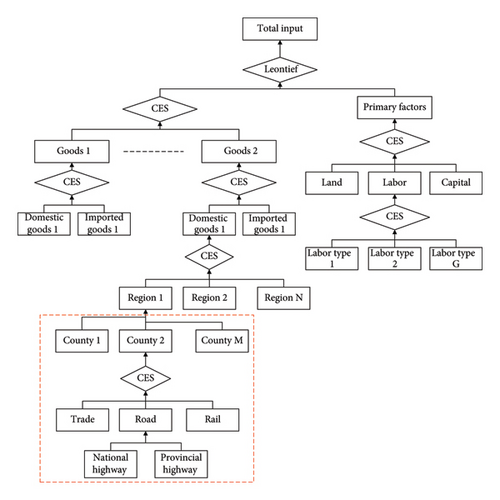
The database construction process is as follows: The first step: Construction of the ORANI-G Database: Initially, we constructed the ORANI-G Database based on the 2020 Competitive Input–Output Table published by the National Bureau of Statistics of China. This database covers 153 economic sectors, including three primary factors (labor, capital, and land) and six economic agents (production, investment, households, government, foreign sector, and inventory), as well as three types of circulation services (trade, transport and storage, and insurance). The capital matrix was constructed with reference to the data structure of the 2002 ORANI-G Database, with fixed investment data allocated to industries using an industry output weighting method to ensure data applicability and accuracy.
The second step: Construction of the County–TERM Database: Building on the 2020 ORANI-G Database, we employed a bottom-up data disaggregation approach. By incorporating the 2017 Competitive Input–Output Tables for each province, we refined the provincial-level model database for 153 sectors [24]. Special attention was given to the detailed matrices of provincial production, investment, private consumption, exports, government consumption, and inventory, as well as the import matrix, ensuring high precision in revealing the regional economic structure.
The Third Step: Construction of the Gansu Province County–TERM Database: For the County–TERM Database construction, we adapted the database construction methods from Horridge and the gravity model to refine the data to the county level. This process integrated economic statistical data at the county level in Gansu Province, including value-added for primary, secondary, and tertiary industries; fixed asset investment; and per capita disposable income. Using a top–down approach, we ensured the database’s accuracy and practical utility in regional economic analysis.
The database system constructed in this study is not only technically innovative but also provides robust data support for the CGE model analysis of county-level economies in Gansu Province. Through precise data processing, we are able to explore the specific impacts of smart highway construction on the county-level economy in Gansu Province, offering scientific evidence for policymaking.
4.2. Data Description and Model Shock
We employ the GEMPACK software and follow the model construction approach proposed by Horridge and Wittwer [24], resulting in a framework that includes 153 sectors and 120 regions. These regions cover 33 provincial-level administrative units in China (excluding Hong Kong, Macau, Taiwan, and Gansu) as well as 87 counties within Gansu Province. The construction of the database primarily relies on national and regional input–output tables, all based on the most recently available data. Although there are temporal inconsistencies between the national and provincial input–output tables, these discrepancies do not significantly affect the model’s structure or simulation results. This is because the regional input–output tables are used mainly to estimate the regional shares of national aggregates, and their structural characteristics remain largely stable in the short-term. The main data sources for database construction are shown in Table 1.
| Year | Data |
|---|---|
| 2020 | National Input–Output Table |
| 2017 | Input–Output Tables of Chinese Provinces |
| 2020 | Statistical table of County-Level Economy in Gansu Province |
The primary objective of this paper is to investigate the impact of transportation infrastructure construction on inter-regional trade flows and economic development. To prevent excessive fragmentation of regions, the 86 counties in Gansu Province were merged into five regions according to the research needs, in addition to six other regions in China, making a total of 11 regions, as shown in Table 2.
| Added regions | Regions | |
|---|---|---|
| Other regions | Eastern region:(E) | Beijing, Shanghai, Jiangsu, Zhejiang, Guangdong, Tianjin, Fujian, Shandong, Hebei, Hainan |
| Northeastern (NE) | Liaoning, Jilin, Heilongjiang | |
| Southwestern (SW) | Guangxi, Chongqing, Sichuan, Guizhou, Yunnan, Tibet | |
| Northwestern (NW) | Qinghai, Xinjiang | |
| Northern region (N) | Shaanxi, Inner Mongolia, Ningxia | |
| Central region (M) | Hunan, Anhui, Jiangxi, Henan, Hubei, Shanxi | |
| Gansu | Southern Gansu (GN) | Gannan Tibetan Autonomous Prefecture, Linxia Hui Autonomous Prefecture |
| Hexi Corridor (HX) | Jiayuguan City, Jinchang City, Jiuquan City, Wuwei City, Zhangye City | |
| Eastern Gansu (LD) | Pingliang City, Qingyang City | |
| Southern Gansu (LN) | Longnan City, Tianshui City | |
| Central Gansu (LZ) | Baiyin City, Dingxi City, Lanzhou City | |
- Note: Source: Authors’ summary. Due to the large number of county names, they are directly classified into their respective prefecture-level cities in the table. “Other regions” refers to the Chinese mainland except Gansu.
To facilitate subsequent industry analysis, this study further consolidates the 153 detailed industries involved in the TERM model into 21 major industrial sectors. This consolidation primarily retains industries that are either dominant in various cities or closely related to the focus of this model’s impact. For instance, traditional industries such as nonferrous metal metallurgy and sectors closely associated with the subject of this study, such as road freight transport, are maintained (refer to Table 3).
| Code | Department name |
|---|---|
| 1 | Crops |
| 2 | Forest |
| 3 | Livestk |
| 4 | OtherAg |
| 5 | Mine |
| 6 | OtherMA |
| 7 | PetrolCoal |
| 8 | Chem |
| 9 | NmenProc |
| 10 | BFerrProc |
| 11 | NFerrProc |
| 12 | EquipManu |
| 13 | ProEquipManu |
| 14 | ElecSteam |
| 15 | Construction |
| 16 | Urbantrans |
| 17 | Transport |
| 18 | Othermar |
| 19 | InforSoft |
| 20 | CommerclSrvc |
| 21 | OtherSer |
- Note: Source: Authors’ summary.
In the aspect of model shock measurement, this paper takes the growth in transportation mileage as a proxy for the improvement in trade facilitation levels and incorporates the increase in highway construction investment as the investment promotion effect into the model. Specifically, in the calculation of transportation mileage, the planned mileage of selected projects in the “Gansu Province’s 14th Five-Year Plan for Highway and Waterway Transportation Development” is organized by county, thereby obtaining the additional high-speed mileage between counties in Gansu Province during the 14th Five-Year Plan period. On the other hand, utilizing the national highway vector database published by OSM as of April 2020, and employing ArcGIS to calculate the mileage of national and provincial highways in each county of Gansu Province in 2020, the mileage of highways between counties is similarly transformed. Thus, the growth rates of national and provincial highway mileage are obtained.
In terms of the calculation of highway construction investment growth, the planned investment amounts for demonstration projects in the “Gansu Province’s 14th Five-Year Plan for Road-Derived Economic Development” and selected projects in the “Gansu Province’s 14th Five-Year Plan for Highway and Waterway Transportation Development” are referenced. The average investment amounts for different national and provincial highway routes are organized. Based on the “Gansu Development Yearbook (2018),” the total fixed asset investment of the whole society in each county of Gansu Province in 2017 is obtained. By using the proportion of fixed asset investment corresponding to the “road transportation industry” in the 149 sectors of the “Gansu Province Input–Output Table” as a weight, the total fixed asset amount of the road transportation industry in each county of Gansu Province is calculated, and the investment growth ratio is derived. The calculation results are shown in Figure 3.


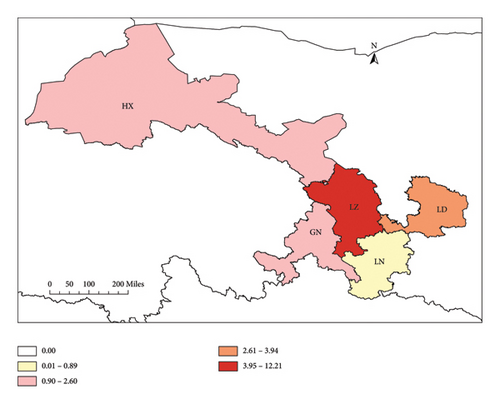

Considering the lag in the economic effects of transportation infrastructure construction, this paper sets policy scenarios under short-term closure and long-term closure. The terms “short-term” and “long-term” do not refer to specific durations but rather to the closure conditions and economic assumptions of the model. In the short-term scenario, which follows a Keynesian closure, the capital stock of each economic sector cannot adjust promptly, allowing the rate of return on capital to vary freely. Since full employment is not achieved, the quantity of labor can vary, but the assumption of sticky wages makes the real wage an exogenous variable. In the long-term scenario, which follows a neoclassical closure, the capital stock of each sector can vary, and the equilibrium of the capital market ensures that the rate of return on capital reaches a steady state. With the market in full employment, the quantity of labor remains constant, and real wages can adjust promptly.
5. Analysis of Simulation Results
5.1. Macroeconomic Impact Analysis
Overall, compared to the short-term scenario, the macroeconomic impact of highway construction on various regions is significantly greater in the long-term scenario, as shown in Table 4. For the regions in Gansu Province, the actual GDP of Longzhong (LZ), Hexi (HX), Longnan (LN), Longdong (LD), and Gannan (GN) increased by 2.998%, 1.869%, 3.275%, 1.643%, and 1.327% in the long-term, respectively. These figures are notably higher than those in the short-term scenario, which were 0.311%, 0.127%, 1.435%, 0.205%, and 0.682%, respectively. In the long-term, the actual economic growth led to an expansion in demand, which in turn caused a moderate increase in the GDP price index.
| Short-term | Long-term | |||||||
|---|---|---|---|---|---|---|---|---|
| RealGDP | PGDP | Export | Import | RealGDP | PGDP | Export | Import | |
| E | 0.001 | −0.003 | 0.009 | −0.003 | −0.019 | −0.016 | 0.040 | −0.017 |
| M | 0.001 | −0.003 | 0.011 | −0.003 | −0.020 | −0.017 | 0.038 | −0.022 |
| N | 0.000 | −0.006 | 0.013 | −0.003 | −0.012 | −0.005 | 0.011 | −0.012 |
| SW | 0.001 | −0.004 | 0.011 | −0.003 | −0.022 | −0.018 | 0.035 | −0.024 |
| NE | 0.001 | −0.004 | 0.013 | −0.003 | −0.024 | −0.021 | 0.046 | −0.032 |
| NW | −0.001 | −0.008 | 0.019 | −0.005 | −0.004 | 0.008 | −0.023 | 0.010 |
| LZ | 0.311 | −0.300 | 0.981 | 0.175 | 2.998 | 2.710 | −4.463 | 8.176 |
| HX | 0.127 | −0.235 | 0.644 | −0.035 | 1.869 | 1.381 | −3.111 | 5.075 |
| LN | 1.435 | −0.361 | 2.463 | 1.809 | 3.275 | 0.535 | 0.146 | 7.190 |
| LD | 0.205 | −0.184 | 0.568 | 0.065 | 1.643 | 0.994 | −2.234 | 4.777 |
| GN | 0.682 | −0.172 | 1.501 | 0.955 | 1.327 | 0.178 | −0.052 | 4.619 |
- Note: Data source: Organized by the authors based on simulation results. The imports mentioned in the tables and text include not only the inflows from other countries but also those from other regions within the country. Similarly, exports encompass not only the outflows to other countries but also those to other regions within the country.
It is worth noting that, in the short-term scenario, overall, there was a slight increase in both exports and imports in various regions of Gansu Province. However, in the long-term, exports in these regions decreased significantly, while imports expanded rapidly. For example, in the LZ region, exports and imports changed by 0.981% and 0.175%, respectively, in the short-term, while in the long-term, they changed by −4.463% and 8.176%, respectively. This indicates that the large-scale construction of highways has, to some extent, altered the internal industrial structure of Gansu Province and affected the economic and trade linkages between Gansu and other regions in China.
5.2. Analysis of Industry Output Impact
The promotion of highway construction generally has a positive effect on the output of various industries in different regions of Gansu Province. This is especially true for the metal and nonmetal processing industries across Gansu, as well as the agricultural and pastoral development in LN and GN regions. Moreover, there is a significant disparity between the long-term and short-term impacts on output promotion, as demonstrated by the comparison of Figures 4 and 5. Taking the long-term simulation results as an example, the output growth in the construction industry is the most significant, followed by the nonmetallic mineral products industry. In the LZ, HX, LN, LD, and GN regions, the output of the construction industry increased by 23.21%, 10.21%, 7.35%, 10.42%, and 8.80%, respectively. Meanwhile, the output of the nonmetallic mineral products industry increased by 12.75%, 8.12%, 13.21%, 8.19%, and 10.68%, respectively.
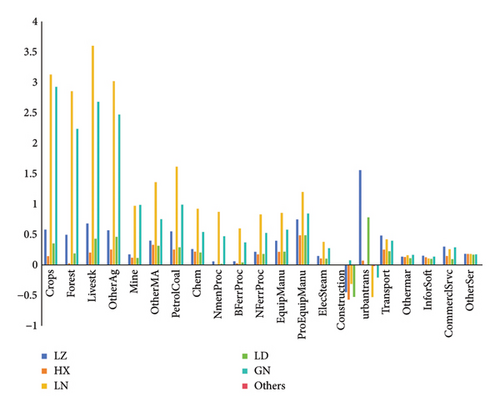
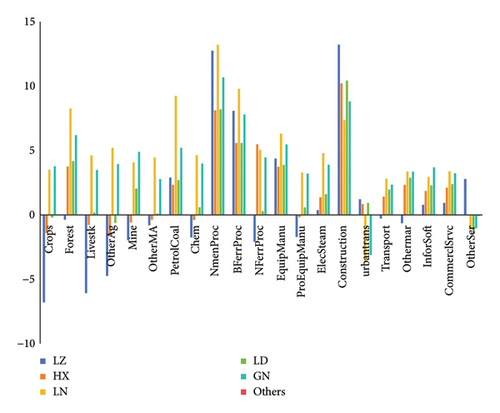
The primary reason is that the improvement of transportation infrastructure directly stimulates the output of the construction industry. Nonmetallic mineral products, such as glass and cement, are the main intermediate inputs for the development of the construction industry. Through the linkage of upstream and downstream industries, the output growth of corresponding industries is promoted. In addition to the nonmetallic mineral products industry, the development of the construction industry also drives the development of the metal smelting industry, represented by steel rebar, and promotes the positive growth of metal smelting output in various regions of Gansu Province.
It should be noted that in the long-term scenario, the development of the primary industry in LN and GN is relatively prominent. Compared to the baseline scenario, agricultural output increased by 3.50% and 3.77%, respectively. However, in the LZ and HX regions, agricultural output decreased by 6.79% and 1.42%, respectively. This indicates that the improvement of transportation infrastructure has enhanced the internal economic division of labor and cooperation within Gansu Province, promoting the interconnectivity of industries and trade among different regions within the province.
Equation (12) decomposes the change in output into three parts: the impact of changes in local market demand (L∗Shr/X)∗l, the impact of changes in local market share (L∗Shr/X)∗shr, and the impact of changes in export demand (E/X)∗e.
The decomposition reveals that the primary driver of industry output growth in Gansu is the expansion of local market demand within the province. Figures 6 and 7 illustrate the percentage decomposition of output changes in various industries of Gansu Province under the short-term and long-term scenarios, respectively, relative to the baseline. In the short-term, this growth mainly comes from the expansion of local market demand, followed by increases in export demand. In the long-term, output growth in most industries is largely driven by the expansion of local market demand, with changes in local market share and export demand having minimal impact. This is particularly evident in industries such as construction, nonmetallic mineral products, and ferrous metal smelting. Thus, improvements in transportation infrastructure have significantly enhanced economic vitality within Gansu and are crucial for the internal economic circulation of the province.
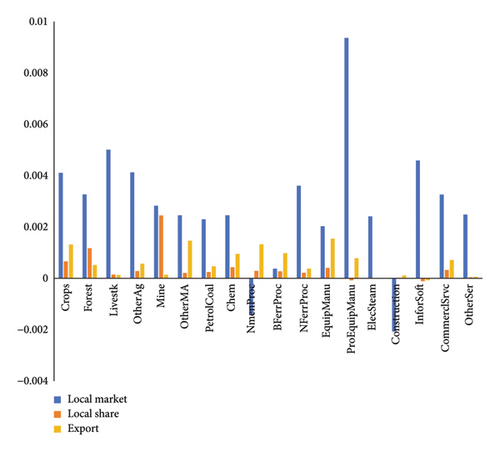

5.3. Analysis of Regional Trade Flow Impact
In the short-term, the resource supply capacity of each region in Gansu Province is enhanced, while in the long-term, there is a greater emphasis on internal connectivity within the province, with the core beneficiary being the economically advantageous regions. The analysis above shows that the transportation infrastructure projects in Gansu Province have promoted the expansion of domestic demand. To further analyze the changes in circulation between different regions, this paper focuses on the changes in inter-regional trade flows.
As shown in Figure 8, in the short-term scenario, the improvement of transportation infrastructure has driven the outflow of resources from various regions in Gansu to other regions in China. For example, the outflow of resources from the LZ region to the Southwest region has increased by 0.8%, and there are also varying degrees of support for other regions within the province. Overall, it tends to act as a resource supplier. In the long-term scenario, the level of resource supply from each region in Gansu to other regions in China has significantly decreased, while the ability to absorb resources from other provinces and the degree of internal economic interaction have been significantly enhanced. In particular, the LZ region, which has economic development advantages, not only absorbs a large number of resources from other provinces but also further aggregates resources within the province, further strengthening its development advantages. Regions with relatively weaker economic development, such as GN, have enhanced their ability to absorb resources from other provinces and improved their own supply capacity. However, the outflow to the economically advantageous regions within the province is relatively prominent.
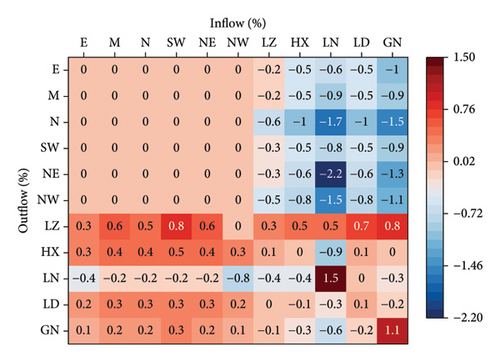
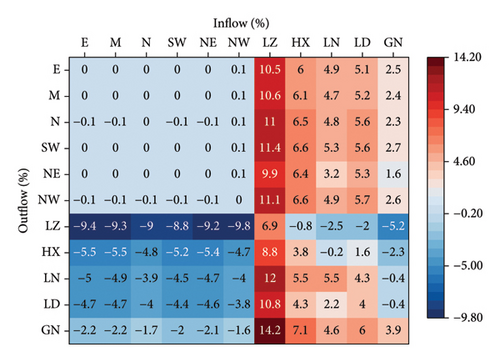
Both national and provincial highway constructions promote the inflow of resources from other regions in China to Gansu Province, especially playing a key role in LZ, where Lanzhou is located. However, there is a certain tendency for resource agglomeration within the Gansu Province. Since different types of highway construction projects may have differentiated impacts on trade flows and volumes in different regions, the impacts of highway construction projects under the long-term scenario are divided into national and provincial highways for heterogeneous analysis, which is shown in Figure 9. It can be found that LZ’s absorption of resources from other provinces mainly comes from national highway construction, while HX, LN, LD, and GN regions also obtain support from resources outside the province through both national and provincial highways. Nevertheless, provincial highways break down the transportation barriers within Gansu Province, which is of great significance to intraprovincial trade. It is worth noting that although the GN region obtains certain support from resources outside the province through national highway construction, it mainly serves other regions within the province. Under the long-term scenario, through provincial highway construction, GN’s trade output to LZ, HX, LN, and LD increased by 4.5%, 4.7%, 3.6%, and 3.4%, respectively, while its trade input from these regions decreased by 1.2%, 1.4%, 0.4%, and 0.3%, respectively. LZ increased its trade inflow from HX LN, LD, and GN by 6.3%, 8.2%, 8.1%, and 9.3% through national highway construction and by 1.8%, 3.0%, 2.6%, and 4.5% through provincial highway construction, respectively. This indicates to some extent that from a national perspective, the construction of transportation infrastructure in Gansu Province has promoted the regional economic development of Gansu. While strengthening road connectivity within the province, it has also accelerated the regional agglomeration effect of resources.
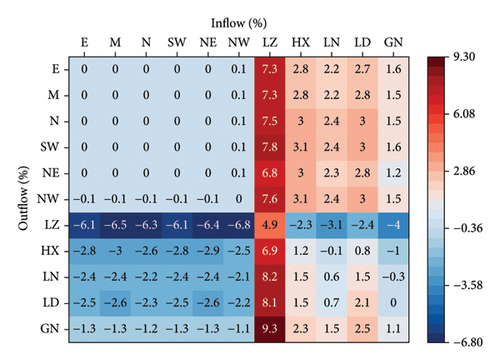
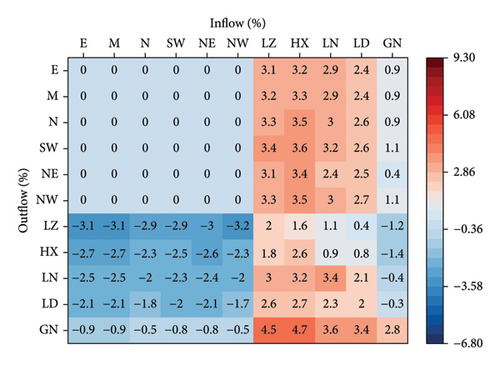
5.4. Analysis of Impact Mechanisms
The construction of transportation infrastructure promotes trade cost reduction and the development of regional economies of scale through the increase in road mileage, namely, the trade facilitation effect. It also stimulates market demand expansion and drives the linkage development and capital accumulation of upstream and downstream industries through investment growth, namely, the investment promotion effect. The decomposition of the trade promotion effect and the investment promotion effect under the long-term scenario, as shown in Figure 10, reveals that the investment promotion effect is stronger than the trade facilitation effect. While trade facilitation is an important reason for trade flows between regions within Gansu Province, the investment promotion effect plays a more significant role. It is the core reason for the absorption of resources from other provinces and the promotion of inter-regional trade flows within Gansu. This may be because, first, in the long-term scenario, the model mechanism of capital accumulation in investment posits that new investments are converted into the capital stock of the next period, cycling repeatedly until the model reaches a new equilibrium. The multiplier effect amplifies the impact of investment-driven growth. Second, increased investment in transportation infrastructure fully drives the demand expansion for upstream industries of construction, such as steel and cement. Third, the expansion of the construction industry and its upstream sectors further enhances the tightness of inter-regional trade. While trade facilitation improves transport connectivity primarily through increased highway mileage, its multiplier effect on regional trade development is lower than the investment effect.
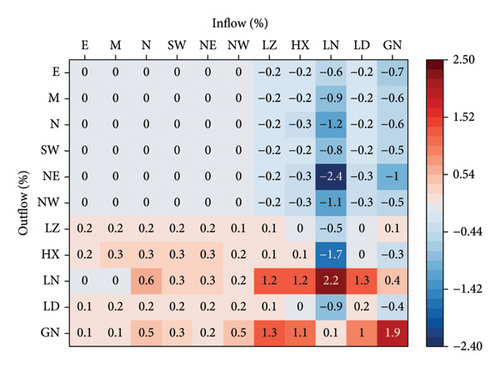
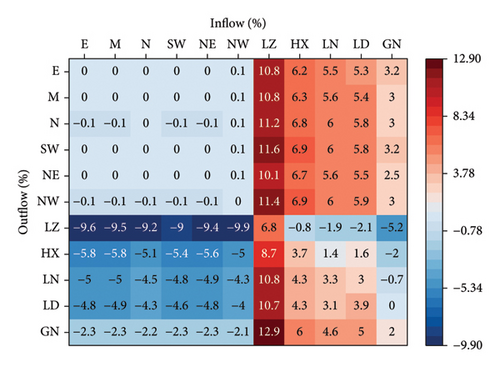
5.5. Robustness Test
To ensure the robustness of the model results, this paper further adjusts key parameters. Given that the primary focus of this study is to examine the impact of transportation infrastructure improvements in Gansu Province on changes in trade flows between different regions and regional economic coordination, the elasticity of substitution between products across regions is increased by 50%. The inter-regional product substitution elasticity is an important parameter for characterizing the interaction between trade costs and inter-regional economic interactions. In existing CGE model literature, when conducting robustness tests, the substitution elasticity is generally adjusted as a key parameter to verify the robustness of research conclusions. This adjustment is made to test the robustness of the conclusions drawn in this study. As shown in Figures 11 and 12, the change in elasticity has a minimal impact on the actual GDP changes in various regions, and the trade changes between regions under both short-term and long-term scenarios remain essentially consistent. This indicates that the conclusions of this study are robust.
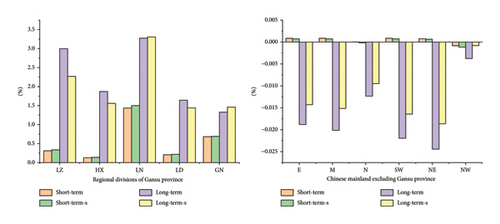
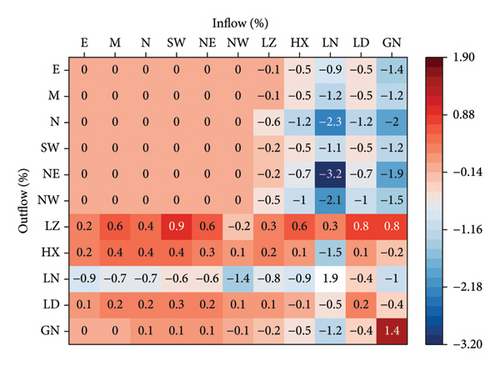
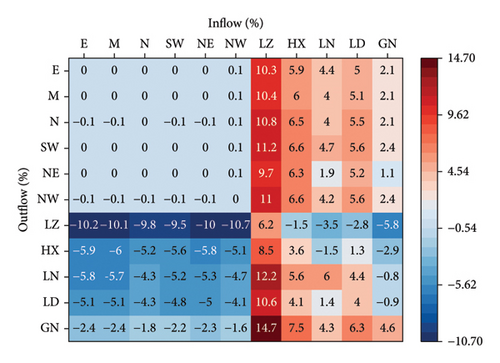
6. Conclusion, Limitations, and Future Works
6.1. Research Conclusions
This paper primarily employs a general equilibrium analysis model (TERM) to investigate the impact of transportation infrastructure projects in Gansu Province on inter-regional trade flows and development synergy. The main conclusions are as follows.
6.1.1. Positive and Time-Varying Impact on Regional Economic Development
The improvement of transportation infrastructure has a positive impact on the regional economic development of Gansu Province, with significant temporal differences, where the long-term impact is greater than the short-term impact. The promotion of industry output is characterized by structural and regional heterogeneity. The construction industry and related sectors significantly benefit, while the agricultural and pastoral industries show regional differentiation, with notable long-term increases in agricultural output in LN and GN. The drivers of output growth are mainly local market demand (the primary factor) and outflow demand in the short-term, while in the long-term, they are almost entirely driven by the expansion of local market demand, reflecting the sustained release of internal demand due to transportation infrastructure improvements.
6.1.2. Trade Flow and Volume Changes: Short-Term Export Orientation and Long-Term Internal Agglomeration
The direction and volume of inter-regional trade flows exhibit the characteristics of “short-term resource export and long-term internal agglomeration.” In the short-term, the trade is oriented towards resource supply: various regions in Gansu export resources to other regions in China, through improved transportation infrastructure. In the long-term, internal circulation is strengthened, with a significant enhancement in the ability to absorb resources from outside the province. Particularly, the LZ region gathers plenty of resources from other provinces through national highways and further attracts resources within the province. Economically disadvantaged regions, such as GN, although improving their own supply capacity, show more pronounced resource outflows to economically advantageous regions (e.g., LZ), reflecting the “Matthew effect” of resource concentration towards advantageous regions within the province. The Matthew effect refers to the phenomenon where “the rich get richer and the poor get poorer,” describing a cumulative advantage that amplifies disparities over time.
6.1.3. Differential Impact of National and Provincial Highways on Trade Flows
National highways are the main channels for importing resources from outside the province, especially for the LZ region’s absorption of external resources, which largely depends on national highways. Provincial highways, on the other hand, are crucial for internal circulation within the province. By breaking down transportation barriers within the province, they promote not only inter-regional trade but also intensify the agglomeration of resources towards advantageous regions such as LZ.
6.1.4. Investment Promotion Effect as the Core Driver of Long-Term Economic Growth
From the perspective of impact mechanisms, the investment promotion effect is the core driving force for long-term economic growth. In the long-term scenario, infrastructure investment leads to capital accumulation, stimulates output in upstream and downstream industries through multiplier effects, and releases market demand potential. The intensity of this effect is significantly higher than that of trade facilitation.
These findings highlight the multifaceted impact of transportation infrastructure on regional economic development and trade dynamics in Gansu Province, emphasizing the importance of both investment promotion and trade facilitation in driving long-term economic growth. While the study provides a detailed analysis of Gansu Province, a brief comparative analysis with other provinces or regions in China could provide additional context and highlight the unique characteristics of Gansu’s economic and geographic landscape [25]. For instance, compared to other western provinces, Gansu’s findings on the impact of transportation infrastructure on regional economic development are similar in that both national and provincial highways play crucial roles in promoting trade and economic growth [26]. However, the specific effects vary due to regional economic structures and sector-specific needs. In more developed eastern regions, the impact of transportation infrastructure on economic growth is more pronounced, especially in terms of market integration and industrial agglomeration [27]. This suggests that while Gansu’s transportation infrastructure development is essential for its economic progress, the unique challenges and opportunities presented by its geographic location and economic structure require tailored investment strategies and policy interventions.
6.2. Limitations of the Study
The study offers insights into transportation infrastructure’s regional development impact but has limitations. First, scarce county-level data led to assumptions in the model database, potentially skewing the depiction of regional economic dynamics, industrial heterogeneity, and microeconomic behaviors. Second, it overlooks the environmental impacts of infrastructure construction, which is critical in Gansu’s ecologically sensitive areas such as GN and LN. Ignoring these costs may underestimate environmental constraints’ long-term economic impact. Third, focusing solely on Gansu’s limits, the findings’ generalizability, and comparison with other regions, future research should address these limitations by integrating detailed data, assessing environmental impacts, and expanding the sample scope for broader applicability.
6.3. Future Research
Future research should obtain detailed county-level data to enhance model accuracy. Collaborating with local statistical departments and industry associations can provide more granular information, improving regional economic simulations. In addition, future studies should assess ecological impacts alongside economic effects, especially in sensitive areas such as GN and LN. Integrating these assessments will support sustainable development strategies. Expanding the sample to include other western provinces or conducting national analyses would reveal regional differences in the economic impacts of transportation infrastructure, providing robust evidence for policy adjustments [28].
Conflicts of Interest
The authors declare no conflicts of interest.
Funding
The authors appreciate the financial support by the National Social Science Fund of China (Project no. 20VMG020).
Acknowledgments
The authors appreciate the financial support from the National Social Science Fund of China (Project no. 20VMG020).
Open Research
Data Availability Statement
The data that support the findings of this study are available from the corresponding author upon reasonable request.




